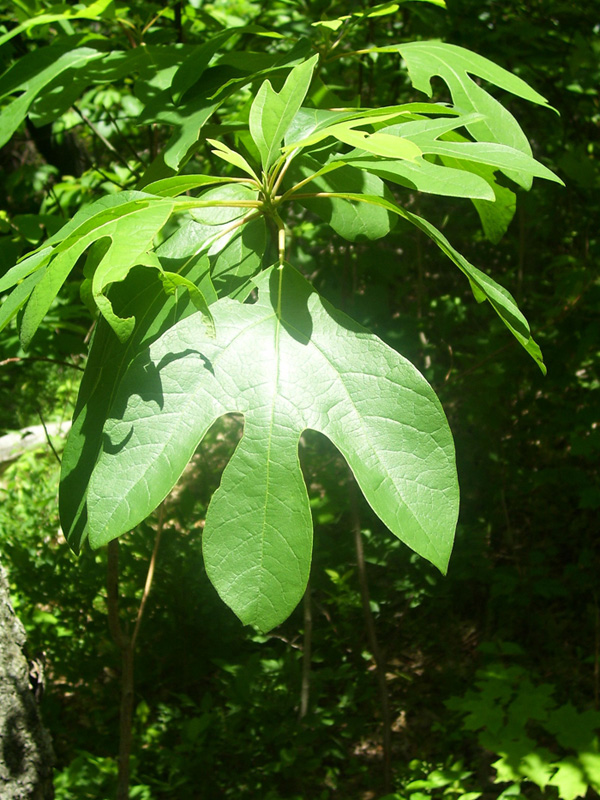- Sassafras
taxobox
name = "Sassafras"
image_caption = "Sassafras albidum",Wanaque, New Jersey
regnum =Plant ae
unranked_divisio =Angiosperm s
unranked_classis =Magnoliid s
ordo =Laurales
familia =Lauraceae
genus = "Sassafras"
subdivision_ranks = Species
subdivision = "S. albidum"
"S. randaiense"
"S. tzumu"|"Sassafras" is a genus of three species of
deciduous tree s in the familyLauraceae , native to easternNorth America and easternAsia .cite journal | author = Nie, Z.-L., Wen, J. & Sun, H. | year = 2007 | title = Phylogeny and biogeography of Sassafras (Lauraceae) disjunct between eastern Asia and eastern North America | journal = Plant Systematics and Evolution | volume = 267 | pages = 191–203 | doi = 10.1007/s00606-007-0550-1 ]Sassafras trees grow from 15–35 m (50–120 feet) tall and 70–150 cm (2.5–6 feet) in diameter, with many slender branches, and smooth, orange-brown bark. The branching is
sympodial . The bark of the mature trunk is thick, red-brown, and deeply furrowed. The wood is light, soft, weak, and brittle. All parts of the plants are very fragrant. The species are unusual in having three distinctleaf patterns on the same plant, unlobed oval, bilobed (mitten-shaped), and trilobed (three pronged; rarely the leaves can be five-lobed).Noble Plant Image Gallery [http://www.noble.org/imagegallery/woodhtml/Sassafras.html Sassafras (includes photo of five-lobed leaf)] ] They have smooth margins and grow 7–20 cm long by 5–10 cm broad. The young leaves and twigs are quite mucilaginous, and produce a scent similar tolemon s when crushed. The tiny, yellowflower s are five-petaled and bloom in the spring; they are dioecious, with male and female flowers on separate trees. Thefruit are blue-black, egg-shaped, 1 cm long, produced on long, red-stalked cups, and mature in late summer.Flora of North America: [http://www.efloras.org/florataxon.aspx?flora_id=1&taxon_id=129310 "Sassafras"] ]The name "Sassafras," applied by the botanist
Nicolas Monardes in the sixteenth century, is said to be a corruption of the Spanish word forsaxifrage .pecies
*"
Sassafras albidum " (Nuttall) Nees - Sassafras, White Sassafras, Red Sassafras or Silky Sassafras. Eastern North America, from southernmostOntario ,Canada through the easternUnited States south to centralFlorida , and west to southernIowa and easternTexas .
*"Sassafras tzumu " (Hemsl.) Hemsl. - Chinese Sassafras or Tzumu. Central and southwesternChina . It differs from "S. albidum" in the leaves being more frequently three-lobed,Arboretum Trompenburg : [http://www.esveld.nl/plantdias/51/51682.jpgSassafras photo] ] the lobes having a tapered acuminate apex (not rounded to weakly acute).
*"Sassafras randaiense " (Hayata) Rehd. - Taiwanese Sassafras.Taiwan . Treated by some botanists in a distinct genus as "Yushunia randaiensis" (Hayata) Kamikoti,Kamikoti, S. (1933). "Ann. Rep. Taihoku Bot. Gard". 3: 78] though this is not supported by recent genetic evidence which shows "Sassafras" to be monophyletic.Usage
Steam distillation of dried root bark produces an
essential oil consisting mostly ofsafrole that once was extensively used as afragrance inperfume s andsoap s, food and foraromatherapy . The yield of this oil from American sassafras is quite low and great effort is needed to produce useful amounts of the root bark. Commercial "sassafras oil" generally is a by-product of camphor production in Asia or comes from related trees in Brazil. Safrole is a precursor for the clandestine manufacture of the drug ecstasy, and as such, its transport is monitored internationally.Importance to Livestock and Wildlife
Sassafras leaves and twigs are consumed by white-tailed deer in bothsummer and winter. In some areas it is an important deer food.Sassafras leaf browsers include woodchucks, marsh rabbits, and blackbears. Rabbits eat sassafras bark in winter. Beavers will cutsassafras stems. Sassafras fruits are eaten by many species ofbirds including northern bobwhites, eastern kingbirds, greatcrested flycatchers, phoebes, wild turkeys, catbirds, flickers, pileatedwoodpeckers, downy woodpeckers, thrushes, vireos, and mockingbirds.Some small mammals also consume sassafras fruits.
Wikimedia Foundation. 2010.
